|
I mentioned the
Chief Vann house on the opening (New Echota) page. If you have not taken
a look yet at his place, you really should. Obviously though, not all
Cherokees were wealthy enough to build and live in plantation style mansions.
Let's see what the map says about this first stop.
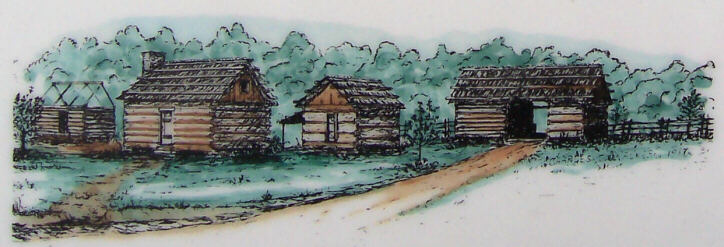
"By 1810 log cabins were the standard Cherokee dwelling
houses. Cherokees were excellent craftsmen and used log construction for almost
every building. By 1837. over 4,000 Cherokee buildings stood in the Georgia
section of the Cherokee Nation. The four buildings on this site were constructed
in the early-mid 1800's and include a dwelling house, corn crib, smokehouse,
and barn. They were moved to New Echota to recreate a typical middle-class
Cherokee farmstead of the early 1800's. A Cherokee building, probably a store
or dwelling house, stood on this site in the 1830's."
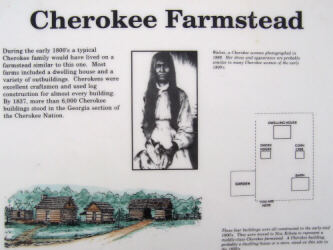 |
|
This sign
next to the buildings indicates, "During the early 1800's a typical Cherokee
family would have lived on a farmstead similar to this one. Most farms
included a dwelling house and a variety of outbuildings. Cherokees were
excellent craftsmen and used log construction for almost every building.
By 1837, more than 6,000 Cherokee buildings stood in the Georgia section
of the Cherokee Nation."
|
The brochure and the sign do not quite agree on the number,
but let's just say there were a lot of Cherokee owned buildings by the 1830's.
No, we did not live in teepees. Never did actually, that is western
plains Indians, or sometimes just pandering to the tourists, because it is
what they expect.
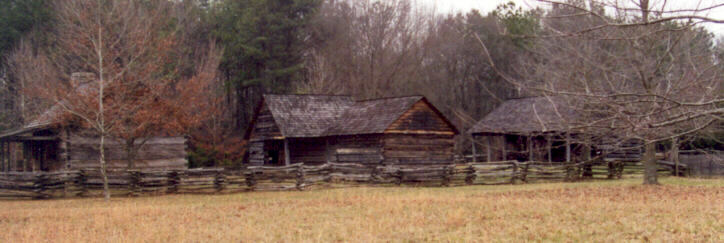
|
"This house
is typical of what a 'middle-class' Cherokee family of the early 1800's
would have lived in. Furnishings in Cherokee homes varied greatly depending
on the wealth of the family. Many of the furnishings were identical
to those white families used, but look for some unique Cherokee features
such as the rivercane blowgun over the door, the ball sticks used to
play anetsa, and the mortar and pestle used to grind corn. Traditional
crafts such as basket weaving, pottery making, and finger weaving were
still in wide use, so Cherokee homes usually had a variety of handmade
items along with other items purchased at local stores."
|
|
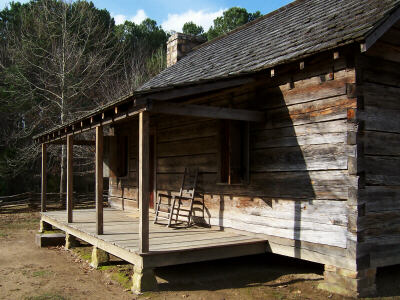 |
| |
|
|
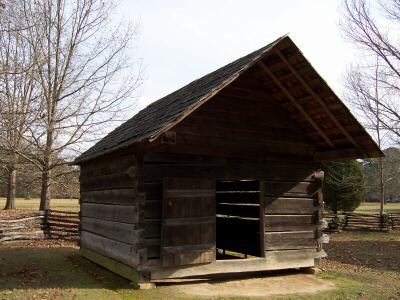 |
|
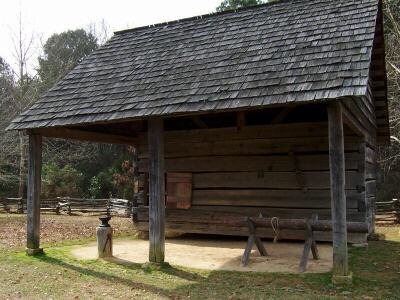 |
| |
|
|
|
"Pork was
the most common meat eaten in the Cherokee Nation during the early 1800's.
Fresh beef, chicken, bear, deer, and turkey were also eaten, but difficult
to preserve for months at a time. Pork was dressed into ham, bacon,
sausage, etc. and kept in the smokehouse. It could be smoked over a
slow fire or cured with salt or other spices to preserve it."
Here is the smokehouse's original meat-cutting bench.
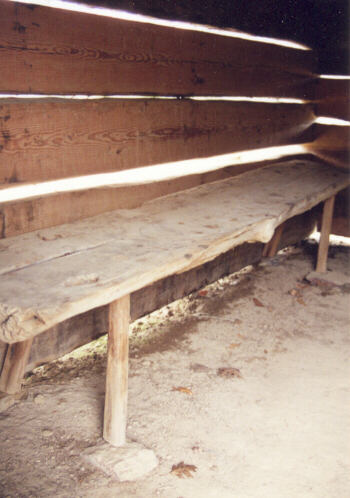
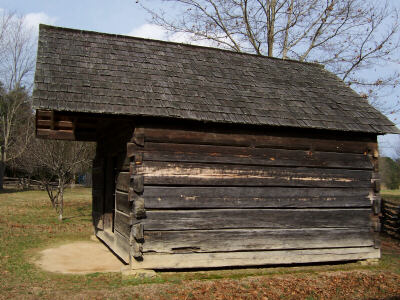
I assume
you figured out, the smokehouse photos (3) go up here on the left, and
the corn crib pictures (3) are located on the right side of the page.
The garden area and barn are below.
|
|
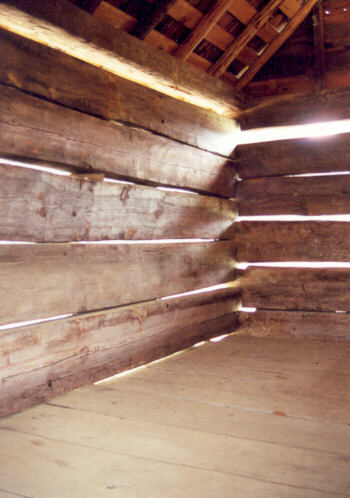
"Corn cribs
were the most common outbuildings in the Cherokee Nation. Almost every
Cherokee farm included one or more cribs. Corn was hauled in from the
field and stored in the crib. Still on the cob and in the shuck it would
air dry sufficiently to be ground into meal, made into hominy, or fed
to livestock. Some cribs, like this one, had 'plunder sheds' to protect
tools and wagons from the weather."
"This crib
includes its original puncheon floor. Puncheons are logs split lengthwise
to present a plank-like surface. By the early 1800's most Cherokee homes
had puncheon floors."
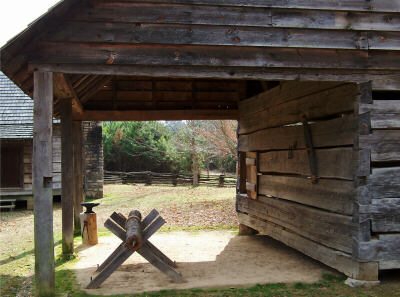
|
| |
|
|
|
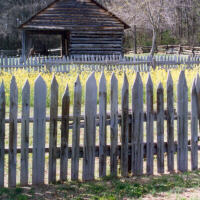
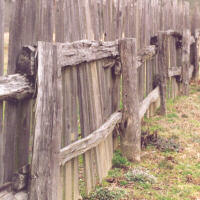
|
|
I have
not visited New Echota during a time of year when I could photograph
planted gardens. But the sign tells us . . .
"During
the early 1800's most Cherokee families made their living by farming.
The average farmstead included fruit trees and a garden near the house
and a large corn field in a nearby river bottom. Hogs and cattle were
allowed to roam freely so each garden and corn field had to be fenced.
Corn was the most important crop raised by the Cherokees.
In 1835 they harvested over one-half million bushels of corn. Surplus
corn was sold and traded to provide cash and goods for the family. Crops
grown by the Cherokees included not only corn, beans, squash, and pumpkins,
but also collards, English peas, lettuce, cotton, watermelons, cabbage,
turnips, cucumbers, peanuts, and onions.
Gourds were often erected to attract purple martins.
Martins were very beneficial since they chased crows and hawks from
the garden and also ate many flying insects."
|
| |
|
|
|
Perhaps
this layout map could have been at the top of the page, but it seemed
more in perspective here.
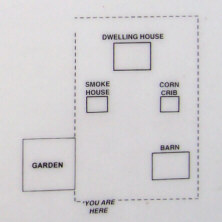
|
|
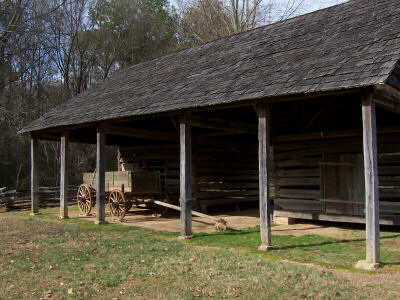 |
"Some Cherokee farms had barns and stables. The drive-through
design of this one provided a protected place for farm equipment and animals.
Milk cows and draft animals were kept in the stalls part of the time, so they
would be close at hand when needed. Beef cattle and hogs were allowed to roam
freely, so each garden and corn field in the Cherokee Nation had to be fenced."
Here are another couple of shots of the interior of the
home, where you can now find an item or two mentioned above. They are
followed by several additional pictures I took of the various structures.
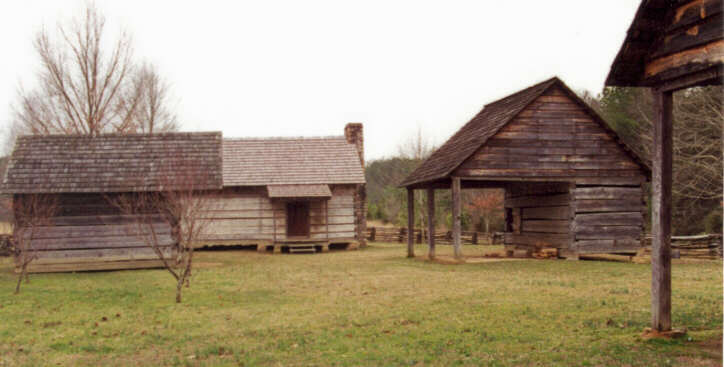
|
The last
item for this page is the photo from the opening sign. The text
tells us her name is "Walini, a Cherokee woman photographed in 1888."
And, the reason she is showing up at this location? "Her dress and appearance
are probably similar to many Cherokee women of the early 1800's."
Well, it
has been a good start. If you visited the museum first, you got
an overview of the whole New Echota picture. You have seen the
photos of several individuals illustrating the dress of the day.
Now you have seen a number of houses and structures, all of which would
have been here in the early 1830's (before removal). Are you getting
a better idea why so many stayed to the very end? Who would have
believed something like forced removal could really be happening?
|
|
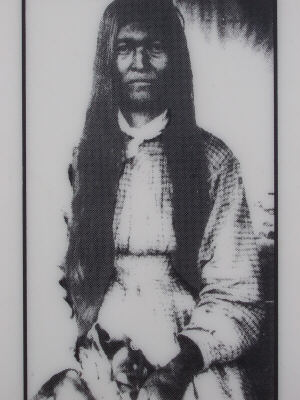
|
"Follow the trail
to your next stop. This part of the trail follows one of the streets laid
out in 1826 by Cherokee surveyors."
|